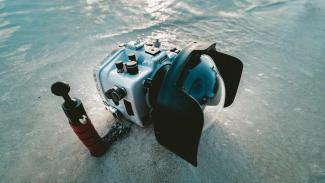
Tara North
So, you are interested in getting into underwater videography? There’s no doubting that it’s an expensive hobby, especially in terms of the equipment you need to buy.
So this means it’s really important to buy the right camera & housing set-up first time - but without experience or being able to test different models underwater, how do you choose the right system for you?
Here, we will try and help you focus on the key aspects, so that you can make an informed decision on your camera & housing and start to enjoy your new hobby straight away.
Which camera?
Setting the Budget
Firstly, what’s your budget? It’s easy to get drawn into the benefits of the next best model, and then the next, and so on. Technology has moved on so fast though that even standard consumer video cameras can now shoot some great footage. You should not feel that a slightly cheaper model would not suit your needs. Also, more expensive cameras and housings come with more expensive add-ons & accessories, plus service & repair costs, which should also be considered when you decide on your budget.
What's the Use?
You should also take time to consider what you want to use your camera for. Do you just want to film for fun on holidays. Are you planning to find work as a videographer with a dive shop? Or do you want to get into TV production and make very high quality underwater productions?
If you want to film just for fun, almost any consumer video camera on the market should be fine and produce images of a good enough quality to enjoy. If you want to work at a dive shop, you need a camera with a little more quality and a few more controls at your disposal underwater, especially the ability to manually set the white balance. Cameras like Sony HC range or Canon HV models are good choices on the market at the moment. You also ideally need a camera that is not too big and that you can easily carry around every day.
If you aspire to make programs for TV or to enter into underwater film competitions, then you need to think a little bigger and go for a camera that is ideally a 3-ccd model that can film in HD quality or above, such as a Sony HDR FX-1 or Canon XL-H1.
Working the System
Another simple decision that you can make straight away is whether you want a PAL video camera or an NTSC model. PAL and NTSC are two differing TV systems that affect your video footage as they use different frame rates. PAL systems record at 25 frames per second, while NTSC systems record at 29.97 frames per second. Generally, NTSC systems are used in North & South America, Japan, Korea & the Philippines, while the rest of the world use PAL. Make sure you pick a camera model that works with TVs for your area.

Jakob Owens

Wuestenigel
Starting on the right foot...
So by this simple thought process, you can narrow down a smaller range of cameras that are suitable for you and also what housing might be better. You will almost certainly be left with a few options though. How do you narrow this down to just one camera & housing? And how do you know you are making the right decision?
Ask the Experts
Firstly, if you are purchasing the equipment from a reputable dealer, they should give you honest advice on the strengths and weaknesses of individual models. Ask around a few different shops and concentrate on the quality of advice, rather than just the price.
Secondly, internet forums are a great place to receive advice or learn of other people’s experiences with a particular camera or housing. There are a range of useful websites with a wealth of information and forum topics, both for video cameras and specifically for underwater photography & videography. Things to consider are if the camera has been on the market long enough to have a good track record; if they are reliable; if you can access all the controls you need underwater; if they are considered to shoot good colours; if they are good in low light situations & if they have any glitches or small design faults.
Give it a Go
Another good option is to take a short course in underwater videography, or make a few try dives with an instructor and a video camera before making your final decision. Once you have a little experience for yourself, then you are in a much better position to make an informed decision on the features of a camera & housing set-up that are most important to you.
By following this process and finding the answers to these questions, you will be able to get an excellent idea of which video camera & housing is right for you - ensuring that you avoid any expensive mistakes & enjoy your new hobby from the word go!

Tara North
You might also enjoy...
Scuba Diving Terms - A Dummies Guide
Frans Daniels







